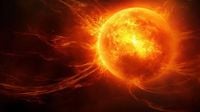On April 15, 2025, residents across the globe, particularly those sensitive to meteorological changes, are bracing for a challenging day as Earth is set to experience two powerful magnetic storms triggered by heightened solar activity. The forecast, provided by the Laboratory of Solar Astronomy of the Institute of Space Research of the Russian Academy of Sciences (IKI), indicates that these geomagnetic disturbances could lead to significant discomfort for millions of people.
The first wave of geomagnetic activity is expected to hit between 08:00 and 10:00 Moscow time, with fluctuations reaching a level of 6 on a 10-point scale, classifying it as a moderate storm. Following a brief lull, a second, more intense storm is anticipated from 14:00 to 16:00, which could reach a strength of 7 points, aligning with the G3 classification on the international scale. Such disturbances can have noticeable effects on the well-being of those who are sensitive to changes in the environment.
According to the latest reports, the solar flare activity index has surged to a critical level of 7.6, indicating a high degree of solar activity. Over the weekend leading up to this event, scientists recorded a total of 39 solar flares, with four categorized as high class M. This surge in activity has been attributed to large protuberances—massive flows of plasma—ejected from the Sun, which are now impacting Earth’s magnetosphere.
Medical experts warn that the symptoms associated with such magnetic storms can include headaches, fluctuations in blood pressure, dizziness, and general malaise. Individuals over the age of 50, particularly those with chronic health conditions such as hypertension or heart disease, are advised to be especially vigilant during this time.
"Magnetic storms can cause a wide range of symptoms for those affected, including headaches and increased anxiety levels," said a spokesperson from the solar astronomy laboratory. "It's essential for individuals to prepare for these storms and take necessary precautions to mitigate their effects."
As the storms approach, doctors recommend several strategies to help those affected cope. Staying hydrated is crucial; individuals are advised to drink at least 1.5 to 2 liters of water daily to avoid dehydration, which can exacerbate symptoms. Additionally, dietary adjustments are recommended, such as reducing salt intake to prevent fluid retention and focusing on foods rich in magnesium and potassium, like fruits, vegetables, fish, and nuts.
Moreover, limiting caffeine and alcohol consumption is advised, as these substances can heighten headaches and trigger blood pressure spikes. Instead of black tea or coffee, switching to green or herbal teas may provide relief. Experts also suggest reducing physical and emotional stress during this period, encouraging activities like meditation, yoga, and light exercise to maintain well-being.
Looking ahead, the geomagnetic activity is not expected to subside quickly. Following the storms on April 15, scientists predict ongoing geomagnetic disturbances, with further storms expected on April 16, and additional activity forecasted from April 17 to 19. This extended period of heightened solar activity is anticipated to continue affecting the magnetosphere, which could lead to more intense storms in the following weeks.
Given the potential for prolonged discomfort, healthcare professionals are emphasizing the importance of monitoring one’s health closely. Those with a history of migraines or cardiovascular issues should regularly check their blood pressure and keep prescribed medications readily available. If symptoms worsen or become unbearable, seeking medical assistance is strongly recommended.
In summary, the magnetic storms set to impact Earth on April 15 are a significant concern for many, particularly those who are sensitive to meteorological changes. With the solar activity at such elevated levels, it is crucial for individuals to take proactive steps to safeguard their health and well-being. The coming days will serve as a test for many, and being informed and prepared can make all the difference.







